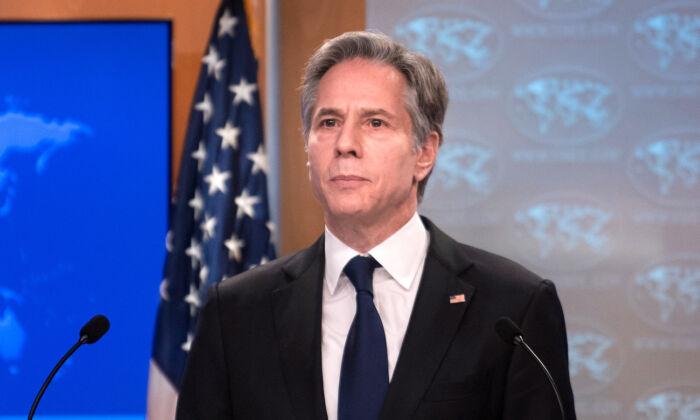The United States and the NATO Western security alliance have responded to Russia’s security demands in separate written statements amid continued diplomatic efforts to reach a resolution over the situation in Ukraine, U.S. Secretary of State Antony Blinken said on Wednesday.
Washington and NATO allies have rejected Russia’s demands but have put forth a number of proposals and are seeking dialogue with Moscow.
Blinken told reporters at the White House on Wednesday that U.S. Ambassador to the Russian Federation John Sullivan delivered the Biden administration’s written responses to the Russian Ministry of Foreign Affairs in Moscow in person. He said the proposals the United States have put forward can address Russia’s concerns while enhancing the security of NATO member nations.

The Biden administration, in the document delivered to Moscow, made clear the core principles it is committed to defending, which includes “Ukraine’s sovereignty and territorial integrity, and the right of states to choose their own security arrangements and alliances,” Blinken told reporters.
“We’ve addressed the possibility of reciprocal transparency measures regarding force posture in Ukraine, as well as measures to increase confidence regarding military exercises and maneuvers in Europe,” Blinken said.
“And we address other areas where we see potential for progress, including arms control related to missiles in Europe, our interest in a follow-on agreement to the New START treaty that covers all nuclear weapons, and ways to increase transparency and stability,” he added.
“I expect to speak to [Russian] Foreign Minister Lavrov in the coming days after Moscow has had a chance to read the paper and is ready to discuss next steps,” Blinken said. “There should be no doubt about our seriousness of purpose when it comes to diplomacy, and we’re acting with equal focus and force to bolster Ukraine’s defenses and prepare a swift, united response to further Russian aggression.”

Stoltenberg told reporters there were three main areas where NATO sees room for progress—NATO-Russia relations; European security; and risk reduction, transparency, and arms control.
He called to re-establish communications and diplomatic ties between Russia and the 30-member alliance to help improve relations and prevent military incidents or accidents.
He also said that NATO is prepared to engage with Moscow in “a real conversation on how to uphold and strengthen the fundamental principles of European security.”
“This includes the right of each nation to choose its own security arrangements,” he noted, calling on Moscow to “refrain from coercive force posturing, aggressive rhetoric, and malign activities directed against Allies and other nations.”
“Russia should also withdraw its forces from Ukraine, Georgia, and Moldova, where they are deployed without these countries’ consent,” he added.
Stoltenberg also offered a series of approaches to increase military transparency and discuss arms control—including on nuclear weapons and missiles. “These areas represent an agenda for meaningful dialogue, and I have invited Allies and Russia to a series of meetings to address all of these issues in greater detail in the NATO-Russia Council,” he said.

Stoltenberg said NATO rejected any attempt to block memberships, like the United States.
“We cannot and will not compromise on the principles on which the security of our alliance, and security in Europe and North America rest,” he said, adding later: “This is about respecting nations and their right to choose their own path.”
Russia’s Response
Russian Deputy Foreign Minister Alexander Grushko told Interfax news agency on Wednesday that Russia will “study” the NATO proposal.“We will read it. Study it. The partners studied our project for almost a month and a half,” he said.
US Tells Americans to ‘Strongly Consider Leaving’ Ukraine
The U.S. State Department on Jan. 23 ordered the evacuation of family members of staff from its Kyiv embassy in Ukraine and urged for all Americans in Ukraine to “consider departing now using commercial or other privately available transportation options.”Blinken on Wednesday reiterated that Americans should “strongly consider leaving” Ukraine, adding that the embassy “may extend loans to those who can’t afford the cost of a commercial ticket.”
“If Russia invades, civilians—including Americans still in Ukraine—could be caught in a conflict zone between combatant forces,” he warned. “The U.S. Government may not be in a position to aid individuals in these circumstances. This has long been the case in conflict zones around the world.”




